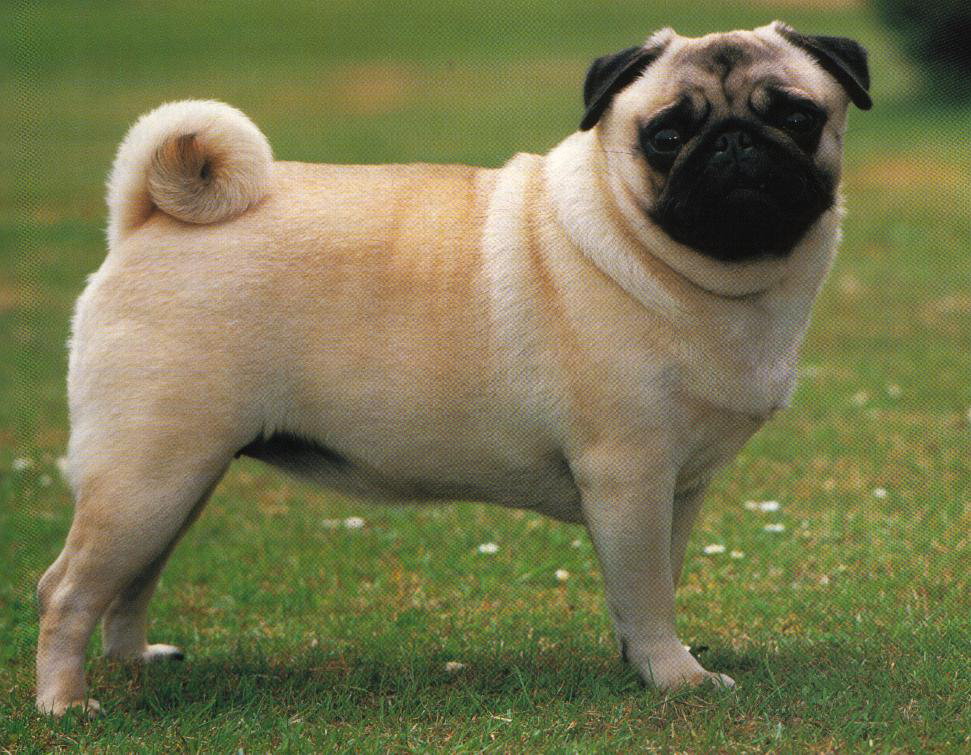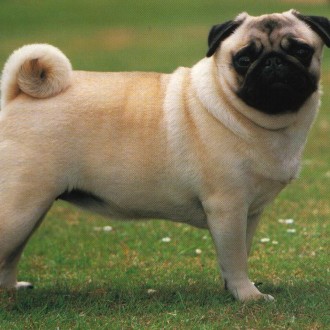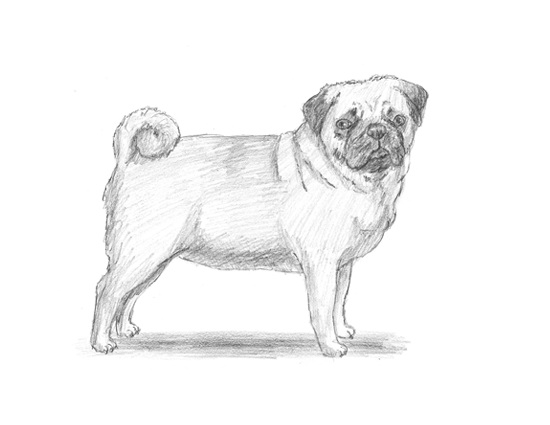


How to Draw a Dog (Pug)
Please PAUSE the video after each step to draw at your own pace (scroll down to see the finished pug dog drawing).
For the first few steps, don’t press down too hard with your pencil. Use light, smooth strokes to begin.
Step 1: Draw two circles as guides for the pug’s body. They don’t have to be perfect. They’re just guides. Pay close attention to the spacing of the circles. If you place them too far apart, your pug dog will end up too long.
Step 2: Draw a slightly smaller circle on the top right side as a guide for the pug’s head. Pugs have big heads, so don’t draw the circle too small. Notice how it overlaps the other circle a bit.
Step 3: Draw two intersecting lines inside the pug dog’s head to help you place the facial features later on.
Step 4: Draw a shape similar to a square with rounded corners on the lower part of the head as a guide for the pug’s muzzle.
Step 5: Draw two triangle shapes on the top of the head as guides for the pug’s ears.
Step 6: Draw a series of curved lines that connect the major shapes to form the pug dog’s body.
Step 7: Draw two lines under the pug’s body (one below each circle) as guides for the legs.
That’s it for the initial sketch! From this point on, press harder with your pencil to get a more defined sketch.
Step 8: Draw the pug dog’s eyes inside the head using the lines as guides for placement. Pugs have eyes that bulge out a bit, so draw the shape as an oval with pointed ends. Inside each eye, draw a circle for the eyeball and another circle within that one for the pupil. Shade the circles in, making sure the pupil is darker than the rest of the eye. Also leave a small circle unshaded to represent glare.
Step 9: Draw the nose above the pug’s muzzle where the two guide lines intersect. Start by drawing an oval, then draw some lines that curl inward for the pug’s nostrils.
Step 10: Use the initial shape as a guide to draw the pug’s muzzle. The mouth is a line that comes down from the nose, splits in two and curls up. Follow the side of the initial square shape but draw more curves and bumps along the way. Draw a few lines on the bottom part for the pug’s lips and chin.
Step 11: Use the triangles as guides to draw the pug dog’s ears. Follow the basic pattern of the ears but make the corners rounder. Also draw a few quick, short strokes at the base to represent the pug dog’s fur.
Step 12: Use the circle as a guide to draw the rest of the pug’s head. Use quick, short strokes as you draw to give the feeling of pug fur. Draw some lines at the bottom to represent folds of skin.
Step 13: Using the lines as guides, draw the pug’s hind legs. Draw lightly at first. When you like what you have, go ahead and darken it. Make the leg thicker on top and draw some bumps along the way to represent joints. Draw a few lines at the bottom for the pug’s toes. Draw only the visible portion of the other leg the same way.
Step 14: Draw the pug’s front legs using the same techniques as the pug’s hind legs. Draw lightly at first to get the structure right, then darken it. Don’t forget the toes! Now draw the other similar-looking leg peeking from the other side.
Step 15: Draw the pug’s tail on the upper left side of the body. Draw a spiral lightly to get the curly tail, then cover it with quick, short strokes to get a furry pug look.
Step 16: Use the remaining lines as guides to draw the rest of the body. Use quick, short strokes throughout to represent fur. Draw curved lines near the pug’s neck and back to represent the loose skin folds.
Step 17 (Optional): You can stop here for a sketchy look or erase as much as you can of the initial guide lines. Don’t worry about erasing all of them. It’s okay to leave some behind. Also re-draw any final sketch lines that you may have accidentally erased.
Step 18 (Optional): Add some shading to your pug dog drawing to give it more dimension and volume. Pick the direction of the light source when shading so that the shadows are consistent with it. Vary the pressure on your pencil to get different degrees of tonal value. Add a cast shadow underneath the pug dog. This helps ground the dog so it doesn’t appear to be floating.
Step 19 (Optional): You can stop here for a white pug dog or you can add more value throughout your drawing for extra detail. It’s a good idea to use reference to be as accurate as possible. For the classic pug look, darken the ears, area around the eyes and muzzle. Remember to PAUSE the video if you need help getting the facial markings right.


